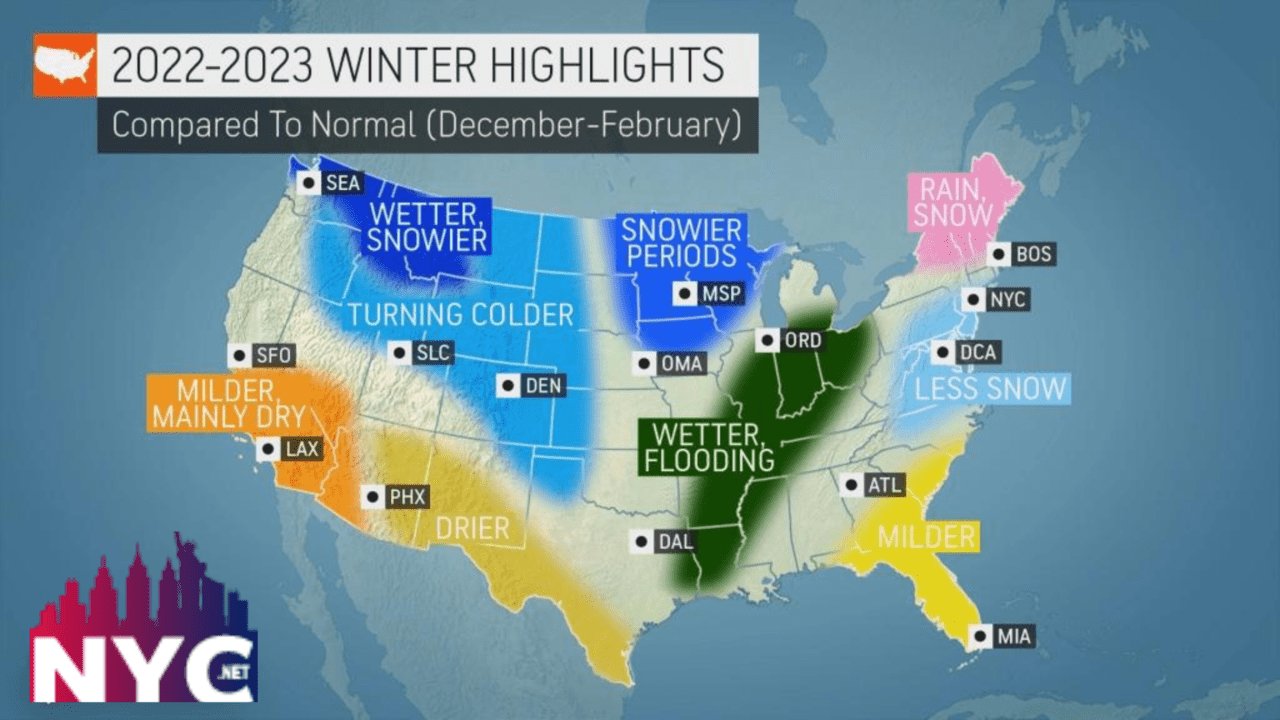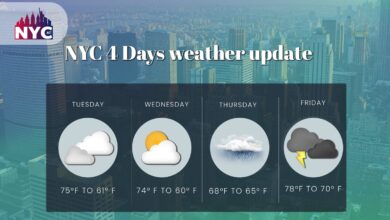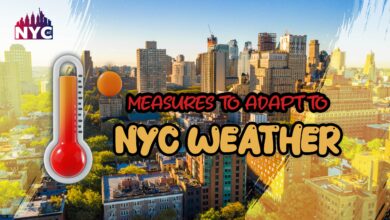AccuWeather’s 2023 Christmas forecast in New York

Warm clothing is a need in New York in January since the temperature ranges from -4°C to 1°C. Between three and eight days of rain are expected in New York in January. Bring your umbrella with you to avoid getting trapped in inclement weather.
In January, New York will have a good amount of snowy days. Building snowmen, sipping hot chocolate, and engaging in snowball fights are all ideal winter activities. Just keep in mind to put on a thick scarf and some gloves.
There may be snow in New York during the holiday. According to Accuweather, residents of the Buffalo area, buried under over 80 inches of lake-effect snow last month, are likely to experience a white Christmas despite mild temperatures for the last half of the month. There will need to be more time for the snow to melt before then.
US winter prediction for 2022–2023 from AccuWeather
Many fantastical predicting methods have been employed throughout the years. It is to get a peek at what the weather would be like in the following winter. It is expected that the number of acorns will fall to the business of squirrel tails. One of its most anticipated seasonal outlooks, the winter forecast, is created by AccuWeather using a slightly different methodology:
A group of skilled long-range forecasters utilizes
- computer models
- historical data
To determine if it will snow this winter, whether and when the polar vortex will unleash Arctic air across North America, and whether it will be a good season for skiers.
AccuWeather winter predictions of New York
The average snowfall at Central Park Climate Station in New York City is 29.8 inches, but only slightly under 18 inches fell there last winter. According to AccuWeather, snowfall totals might surpass that amount, with six to nine days of precipitation leading to 18 to 23 inches of accumulation for the winter.
La Nia’s significant unpredictability, particularly after three seasons in a row where it had an impact, presents forecasters with a challenging problem. According to a press release from AccuWeather, “These third-year La Nias are exceedingly challenging.” [1]
Predictions of white Christmas
AccuWeather’s predicted annual white Christmas weather, with experts noting that while the odds aren’t high for much of the country, a few places may be lucky just in time for the holiday.
Senior Meteorologist Paul Pastelok and the AccuWeather long-range forecasting team have closely monitored significant weather trends that might favor snow in time for Christmas across the United States.
What is La Nina?
According to Pastelok, La Nia, which will be active for the third consecutive winter, is one of the most important weather phenomena. This trend, caused by cooler-than-average seas in the central and eastern Pacific near the equator, frequently pushes a rugged path over the northern tier of the United States while leaving the country’s southern regions drier than usual.
Pastelok claims that his Christmas season would turn out differently than the previous two years despite being the third year in a row with La Nia. The tendency may make a white Christmas, defined as at least an inch of snowfall on Christmas. Less snow is also possible.
Northwest and Rockies will receive fresh snowfall.
Accuweather anticipates a replenishing snowfall in the middle of the month over the Northwest and Rockies. In higher elevations, snow will continue accumulating in the usual places, and there is a high chance of a white Christmas (above 90%). However, the chances are higher than average in Salt Lake City and Denver.
Temperatures may plunge across western Canada and the Northwest in December and January due to a cold weather trend, especially in lower-elevation locations. Major Northwest cities like Seattle and Portland, Oregon, may receive more snow.
What do other organizations’ forecasts say?
Most meteorologists who have provided winter outlooks so far concur that the southern United States will see drier and warmer-than-normal circumstances, with the northern tier, Midwest, and Ohio Valley having the highest chances of experiencing colder and stormier-than-normal conditions.
NOAA’s latest forecast
November, December, and January are the first three months when winterlike conditions develop in earnest; excessive cold is not anticipated anywhere in the nation during these months. Temperatures will be above average throughout the country, from the East Coast southward into the Sun Belt and the Mountain West. Arizona and New Mexico have the highest chances of experiencing unusual warmth.
With the highest likelihood of warmer weather around the Mid-Atlantic and Southeast coastlines, above-normal temperatures may persist from February through April along the East Coast, Southeast, and Southwest. The northern contiguous United States, which stretches from northern Michigan to the north of Washington state, is expected to have below-average temperatures.
Farmers’ Almanac forecast
The Farmers’ Almanac winter snow forecast predicts an early start to winter and a chilly, rainy December. The eastern part of the country forecasts to remain stormy, and the almanac predicts snowy weather in the Northeast. The Farmers’ Almanac predicts that there will be more snow than rain in the Interstate 95 corridor, which frequently marks the rain-snow border for large storms.
WeatherBell’s winter forecast
The Ohio Valley and Upper Midwest are likely to see the coldest temperatures, which may be 1 to 3 degrees below average. In the West, temperatures may be higher; according to WeatherBell, Southwest temperatures will be 1 to 3 degrees above average. Additionally, less snowfall than usual is forecast for that nation’s region. A few well-known ski resorts in California are in that prediction.
What does the astronomical calendar say about winter weather in New York and other US states?
The broad forecast from AccuWeather is the same for both the Philadelphia and New York City regions. Typically, New York City receives 29.8 inches of snow annually, but just 17.9 inches did so last winter. This winter, AccuWeather predicts 18 to 23 inches in New York City.
In contrast to the city’s typical annual snowfall of 23.1 inches, Philadelphia only received 12.9 inches last winter. This winter, 14 to 20 inches of snow are expected, according to AccuWeather. According to the meteorological calendar, winter begins on December 1 and lasts until the end of February since these months often see the lowest temperatures and the most significant snowfall.
The following winter season begins on December 21, 2022, and finishes on March 20, 2023, according to the astronomical calendar, which is based on Earth’s rotation and sun angle. Although AccuWeather predicts a moderate start to the following winter, it also warns that “waves of cold air will plunge down from Canada” in November and December, causing “a few winter previews” for residents of the Northeast and Midwest.
Weather Prediction in coming months
The average temperature for the month is going to be low and expected. The temperature will vary from -8 °C to 8 °C before January 2. The expected weather in new York at the beginning of the month was warm and rainy. The temperature will occasionally rise to 8 °C, which is still lower than January 2021–2022. Precipitation seems sparse during the middle of the season; the majority will fall between January 6 and January 22.
The typical February temperature in 2023 is 0 °C. The month’s hottest day, with a high of 9 °C, is on February 3, while its coldest day, with an average daily increase of -9 °C, falls on February 28. The prognosis for February 2023 is less favorable than it was for the same month during the 2021–2022 season.
Conclusion
Winter 2022-2023 is likely to be cold and sunny. Days will gradually lengthen, as is customary for the season. Winter 2022-2023 will be drier than winter 2021-2022. In general, the season does not call for a lot of precipitation.
This winter’s average temperature is 0 °C, which is lower than winter 2021-2022. Winter 2022-2023 will see 40 days with temperatures exceeding two °C and 29 days below 0 °C.
The average length of daylight will rise by up to 10 hours. The longest day, which will last 11 hours and 12 minutes, will occur on February 28, 2023. The shortest will take place on December 22, 2022, and will last 9 hours and 15 minutes.
FAQs
Q.1: Is December a suitable month to travel to New York?
You’ll discover that December is one of the most enjoyable and exciting seasons to visit New York City if you’re thinking about taking a vacation there.
Q.2: How much snow can New York City anticipate this winter?
The Ocean Weather Services forecasts that New York City’s 2022–23 winter snowfall will most likely range from 22 to 27 inches, which is between the city’s typical annual snowfall of roughly 25 inches.
Q.3: What will the Christmastime weather be like in New York?
Daytime highs are around 43F (6C), and overnight lows are typically 32F. (0C).
Q.4: Will there be a snowstorm in New York City?
At this moment, there is no severe weather affecting NYC. Consult the National Weather Service for forecast updates.
References
[Early NYC winter forecast: Will we get a lot of snow? ..(n.d) (October 3, 2022) From Slive Link: https://www.silive.com/weather/2022/10/early-nyc-winter-forecast-will-we-get-a-lot-of-snow-accuweather-issues-predictions.html



